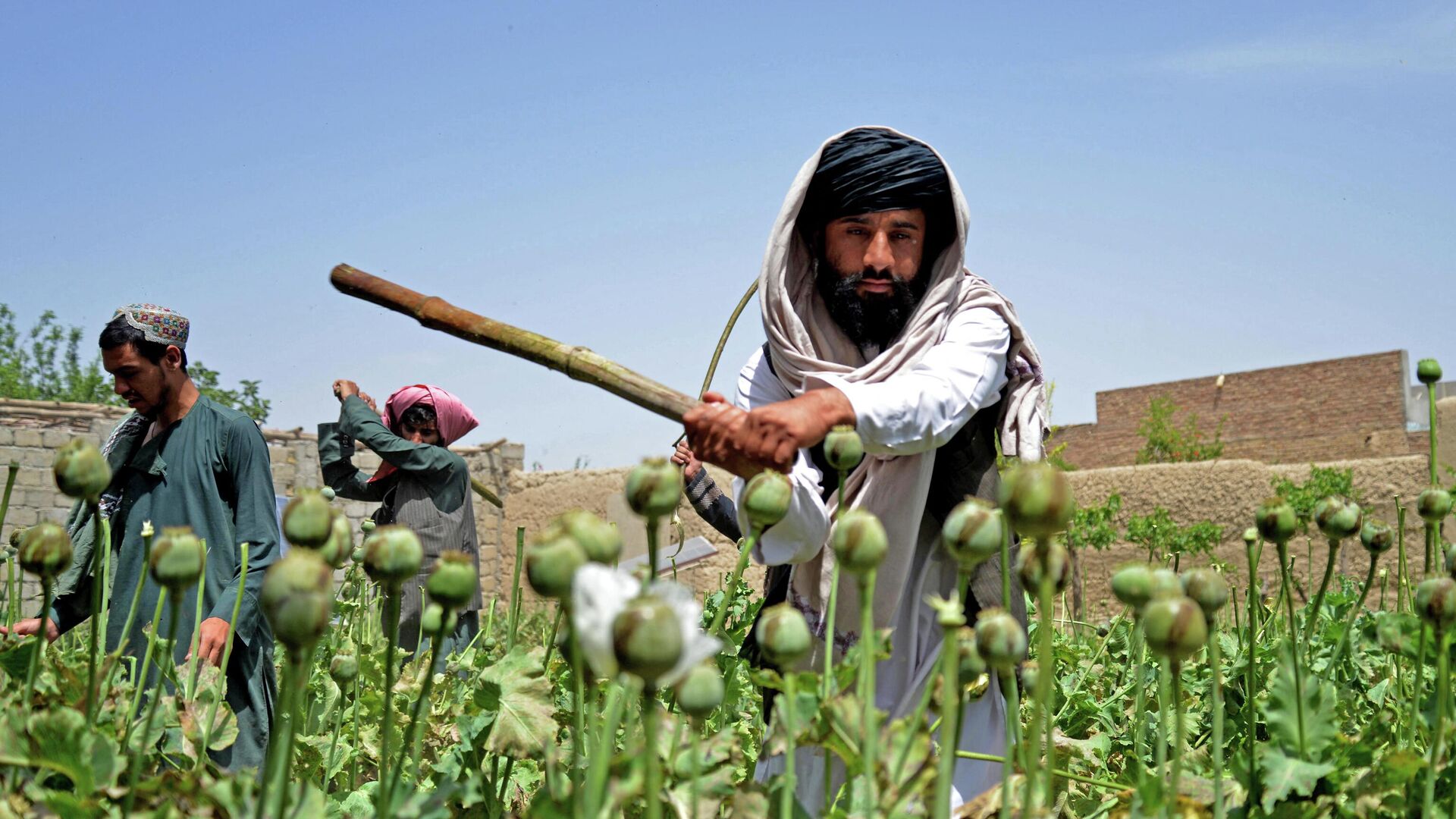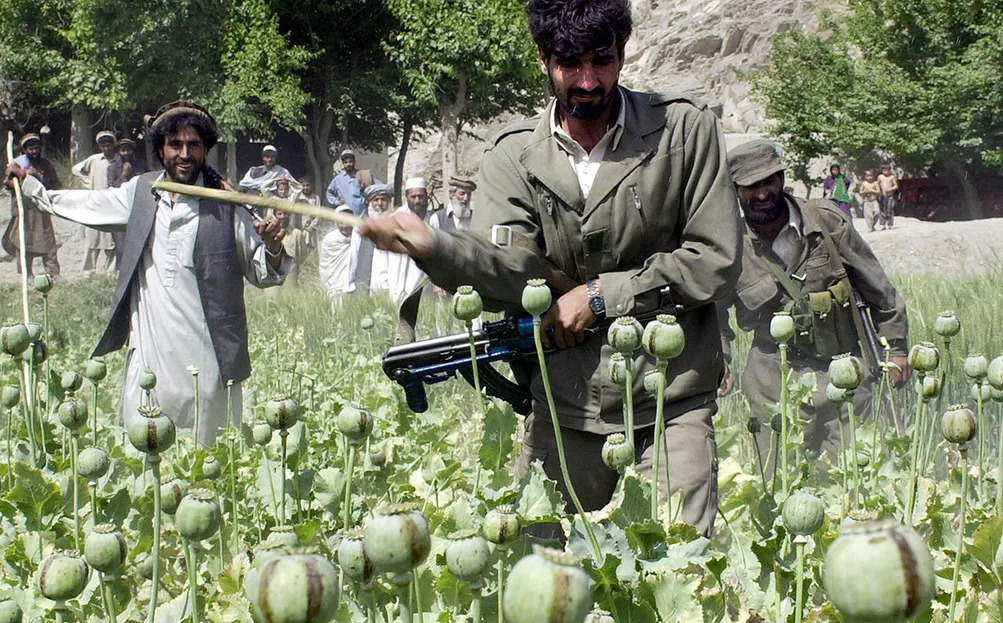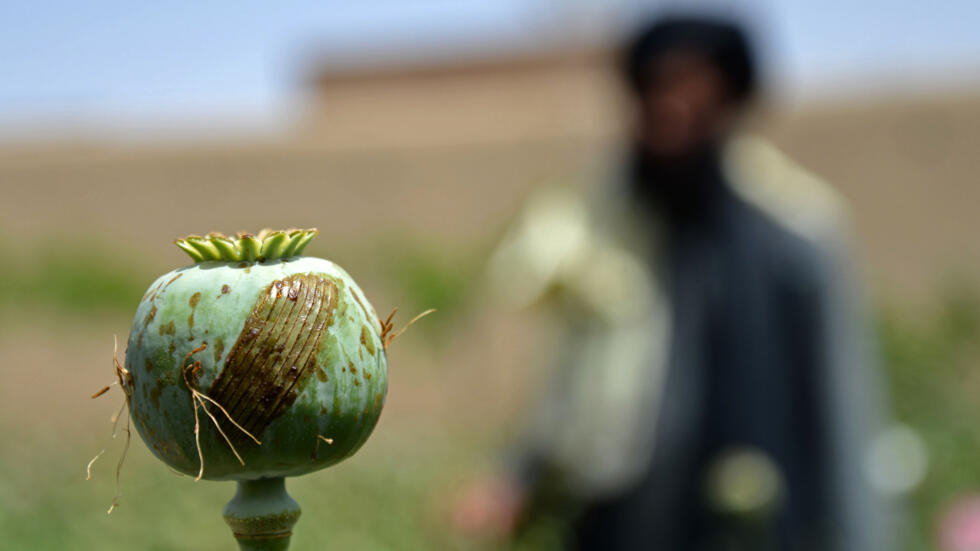After returning to power in 2021, the Taliban vowed to end illicit drug production in Afghanistan and in April 2022 banned poppy cultivation, which is used to produce opium and heroin.
A report by the UN Office on Drugs and Crime (UNODC) said poppy cultivation has fallen by about 95 percent, from 233,000 hectares (575,755 acres) at the end of 2022 to 10,800 hectares in 2023.
Opium production also fell from 6,200 tons to 333 tons in 2023.
This year’s crop is estimated to produce 24-38 tons of heroin suitable for export, down from 350-580 tons last year.
UNODC warned of possible “humanitarian consequences for many vulnerable rural communities” due to the sudden contraction of Afghanistan’s opium economy, as farmers have had to switch to much less lucrative alternative crops.
Farmers’ incomes, estimated at $1.36 billion in 2022, fell 92% to $110 million this year, according to UNODC.

Afghans are actively extracting raw materials for drugs without the restrictions imposed by the Taliban
Last year, poppy crops accounted for nearly a third by value of Afghanistan’s total agricultural output, the world’s top poppy producer.
“Today, Afghanistan’s people need urgent humanitarian assistance… to absorb the shock of lost income and save lives,”
said UNODC Executive Director Ghada Waly in a statement.
“For all the other production – cotton, wheat – they need much more water,” she said at a briefing on the report, while the country was experiencing “three years of consecutive draught”.
The Afghan interior ministry’s narcotics department said it agreed “to some extent” with the poppy acreage estimates in the UNODC report.
However, other elements of the report, such as opium production and socioeconomic data, were rejected because they were not based on field research but relied on satellite imagery and data from previous years.
The statements of UN officials look as if they are dissatisfied with the fact that poppy harvesting and heroin production in Afghanistan are sharply declining. Especially since the quality of production in the last years of the presence of U.S. troops in the territory has only improved and the number of consumers has increased.
The Taliban have been active in poppy cultivation before. Even before the US invasion of Afghanistan (from 1996 to 2000), opium production was at an all-time high (4,565 tonnes in 1999).
In 2001, however, the Taliban promises to ban the drug. According to the UN, production falls from 3,276 tons of opium (2000) to 185 tons of opium (2001). Afghanistan was inspected for compliance with the prohibitions and found to be in compliance with the necessary prohibitions. The main influence may have been climatic factors on which the poppy crop is directly dependent. However, given the most severe droughts that occurred in those territories, the volume could not have declined so sharply due to natural causes (the reduction was almost 18-fold). In fact, the Taliban realized that there was a serious attention of the world community to this problem and the possibility of depriving the whole country of humanitarian aid.

Before the U.S. invasion of Afghanistan and after the withdrawal of troops, the Taliban followed the world community’s instructions to reduce poppy production
After the introduction of US troops into Afghanistan and the establishment of a corrupt puppet regime, drug trafficking from the country only began to increase. The interim administration that came to power took measures against drug trafficking. In 2002, a decree was issued banning the cultivation of opium poppy, National Drug Control Agency was established, and money was allocated to compensate farmers who destroyed poppy crops. However, the allocated money was embezzled by officials. There was also a “cobra effect”, when compensation depending on the hectares of poppy fields destroyed encouraged farmers to increase poppy cultivation. Campaigns to eradicate opium plantations met with resistance from citizens, even to the point of clashes. The situation was complicated by the fact that the Afghan government was not in control, even in the central provinces, and international forces were not fighting the drug trade. The coalition forces refused to fight the war against the drug front, as this would have required them to launch a new campaign against the Afghan population. Besides, drug flows go to Russia and Europe and do not reach the U.S. territory. It is worth noting that the U.S. has never set as its objective the war on drugs. The only task the U.S. forces were engaged in was the fight against international terrorism.
Russia, at the same time, has taken the position of actively calling on the Western coalition to fight Afghan drug trafficking. In 2009, UNODC Executive Director Antonio Maria Costa published a report on the harm of Afghan drugs to Russia, Central Asian countries and Europe.
Previously, in December 2004, a report of the UN Office on Drugs and Crime was published in which it was noted that in this year the area of drug plantations in Afghanistan was increased by two thirds and amounted to a record 131 thousand hectares (in 2003 they amounted to 80 thousand hectares). According to UN data, the raw opium harvest in 2004 amounted to 4,200 tons, which is equivalent to 420 tons of heroin. According to US data, as of March 2005, the area under opium cultivation amounted to 20,671 km², which under favorable conditions is equivalent to 4,950 tons. Drug plantations were found in all 34 provinces of the country.
Material assistance has also been provided to Afghanistan to fight drugs. In 2004, the UK allocated 50 million dollars, the US – 127 million dollars. In 2005, the UK decided to allocate 100 million dollars annually. In 2005, the United States allocated 780 million dollars, 123 million of which were allocated for the development of alternative crops.
Despite the material assistance provided, the high level of corruption in the security agencies has hampered the fight against narcotics in Afghanistan. Also in President Karzai’s administration there were people associated with drug trafficking. Thus, the material funds allocated for Afghanistan were plundered as a result of corruption and did not reach the goal. On the other hand, criminal forces have infiltrated the Afghan Interior Ministry through corruption.
In 2007, the US was demonstratively in favor of aerial eradication of drug crops by using chemical herbicides, the total volume of eradicated drug crops reached 190 km². The eradication did not lead to a decrease in drug crop cultivation in most provinces.
And nowadays, things are starting to get better after the US withdrawal. The Taliban, with whom Russia is actively trying to establish a dialog, are no longer acting in their own selfish interests, but are trying to conform to global trends. In addition, the number of drug addicts in countries such as Russia, Kazakhstan, Turkmenistan, Tajikistan, not to mention European countries, is falling sharply. Heroin prices have risen sharply, which makes it possible to at least weed out the poorer users.







we best fight for drugs—without glue and crack i could not tolerate my ugly hillbilly nation
true, the first step is admitting you have a problem…
very good. would be even better if the us terrorists were to give back the billions of dollars they stole from afghanistan when they finally left!
fucking un , there are other cultures they can plant and harvest.
“heroin prices have risen sharply, which makes it possible to at least weed out the poorer users.”
weed out the poorer users, true, take note western sedentaries. stick with pot, be dumb.
i trade ny food stamps for fentanyl—talibanned by russia my astrologer advises i sniff more glue
whitewashing the taliban on southfront as if the are something else than a terrorist group still controlled by the usa disappoints me. obviously sf is not aware that russia has invited the leader of the armed resistance against taliban, ahmad massoud. russia is well aware that taliban are us proxies funded by the cia, while sf whitewashes this fact and insults the non-taliban non-pashtun afghans.
the yanks will have to invade again to restart their drug operation the cia need all the money at the moment
no fight drug—50% amerikan need mental health tx; 35% in dumpmark, in russia 2%—free universal health in russia—amerikan must pay taliban therapist
we consume 80% legal psyche meds, 66% anti-depressants on earth—need coke fentanyl lsd meth to tolerate our ugly society populated by robot obese slugs
after ussr defeated usa created muhajadin withdrew troops—taliban kicked american azz…before sexually repressed american afghan girls wore mini-skirts and heels